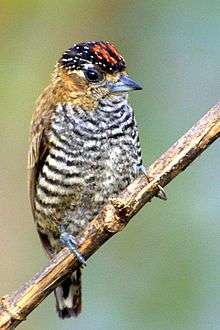Picumnus (bird)
Picumnus is a large genus of piculets. With a total length of 8–10 cm (3–4 in), they are among the smallest birds in the woodpecker family.
| Picumnus | |
|---|---|
 | |
| Ochre-collared piculet, Picumnus temminckii | |
| Scientific classification | |
| Kingdom: | Animalia |
| Phylum: | Chordata |
| Class: | Aves |
| Order: | Piciformes |
| Family: | Picidae |
| Subfamily: | Picumninae |
| Genus: | Picumnus Temminck, 1825 |
| Species | |
|
See text. | |
Species limits in this genus are doubtful, and the rate of interbreeding is "inordinately high" (Remsen et al. 2007). As defined by Winkler and Christie (2002), it contains the 27 species listed below, all from the Neotropics except the speckled piculet, which is Asian (and sometimes placed in a monotypic genus, Vivia).
Their upperparts are brownish, greyish or olive, in some species with darker barring or white or yellowish spotting on the mantle. The underparts vary greatly among the species, ranging from all rich brown in the chestnut piculet, to whitish in the plain-breasted piculet, white with dark bars in the white-barred piculet, and pale yellowish with dark bars on the chest and dark spots and streaks on the belly in the bar-breasted piculet. They have black crowns with red, orange, or yellow marks in the male and white dots in the female, except that the male speckled piculet has brown crown marks and the female lacks white dots. Most have rather short black tails with white stripes down the edges and the center (Blume and Winkler 2003). In two species, the rufous-breasted and the chestnut piculets, the white is largely replaced by rufous.
While the individual species often are habitat specialists (as evident by a number of highly restricted species such as the rusty-necked and ochraceous piculets), members of this genus range from dry Caatinga woodland to humid Amazonian and Atlantic Forest. They are generally found in pairs or small groups. The Neotropical species fall into two broad song groups, with the first having a song consisting of a long trill, and the second a song consisting of series of two or more descending notes.
Species
- Speckled piculet, Picumnus innominatus (or Vivia innominata)
- Bar-breasted piculet, Picumnus aurifrons
- Orinoco piculet, Picumnus pumilus
- Lafresnaye's piculet, Picumnus lafresnayi
- Golden-spangled piculet, Picumnus exilis
- Black-dotted piculet, Picumnus nigropunctatus
- Ecuadorian piculet, Picumnus sclateri
- Scaled piculet, Picumnus squamulatus
- White-bellied piculet, Picumnus spilogaster
- Arrowhead piculet, Picumnus minutissimus
- Spotted piculet, Picumnus pygmaeus
- Speckle-chested piculet, Picumnus steindachneri
- Varzea piculet, Picumnus varzeae
- White-barred piculet, Picumnus cirratus
- Ocellated piculet, Picumnus dorbignyanus
- Ochre-collared piculet, Picumnus temminckii
- White-wedged piculet, Picumnus albosquamatus
- Rusty-necked piculet, Picumnus fuscus
- Rufous-breasted piculet, Picumnus rufiventris
- Ochraceous piculet, Picumnus limae
- Mottled piculet, Picumnus nebulosus
- Plain-breasted piculet, Picumnus castelnau
- Fine-barred piculet, Picumnus subtilis
- Olivaceous piculet, Picumnus olivaceus
- Greyish piculet, Picumnus granadensis
- Chestnut piculet, Picumnus cinnamomeus
- Picumnus sp. nov.? "Serra Geral do Tocantins"
See also
- Genus Sasia
References
- Blume, Dieter; Winkler, Hans (2003), "Woodpeckers", in Christopher Perrins (ed.), Firefly Encyclopedia of Birds, Firefly Books, pp. 408–413, ISBN 1-55297-777-3
- Winkler, Hans; Christie, David A. (2002), "Family Picidae", in del Hoyo, J.; Elliott, A.; Sargatal, J. (eds.), Handbook of the Birds of the World, Volume 7: Jacamars to Woodpeckers, Barcelona: Lynx Edicions, pp. 280–555, ISBN 84-87334-37-7
- Peterson, Alan P. (Editor). 1999. Zoological Nomenclature Resource (Zoonomen). Accessed 2007-09-08.
- Remsen, J. V., Jr., C. D. Cadena, A. Jaramillo, M. Nores, J. F. Pacheco, M. B. Robbins, T. S. Schulenberg, F. G. Stiles, D. F. Stotz, and K. J. Zimmer. [Version 2007-10-07.] A classification of the bird species of South America. American Ornithologists' Union. Accessed 2007-10-07.